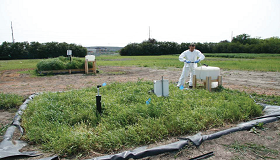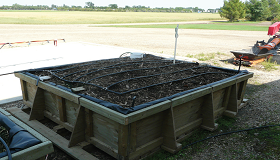Set up an interview
Media Relations
Agriculture and Agri-Food Canada
1-866-345-7972
aafc.mediarelations-relationsmedias.aac@agr.gc.ca
Pesticides are an integral part of much of today's agriculture, helping farmers protect their crops from invasive insects and weeds. Although best practices exist to minimize environmental impacts from their use, pesticides are still often detected in wetlands, rivers, lakes and groundwater.
The pesticide handling area – where sprayers are filled, rinsed and washed – can be a major source of pesticide residues found in waterways surrounding a farm. Using a biobed to treat water contaminated from washing sprayer equipment (called pesticide rinsate) can reduce this contamination source by up to 70%.
Biobeds are cube-like filtering structures designed to remove pesticides from sprayer's rinsate by dripping it through layers of biomixture (or "biomix") - a combination of straw/woodchips, peat/compost and top soil. Biomix soaks up pesticide rinsate and provides the perfect environment for a type of microorganism that uses pesticides as a source of food. Once the rinsate has passed through the biobed, it drips out the bottom as clean water.
From an environmental perspective, biobeds provide a safe and effective solution for managing pesticide rinsate disposal. As pesticides continue to be an important pest management tool, more Canadian growers may use biobeds to improve the environmental performance and sustainability of their farms.
In 2018, Agriculture and Agri-Food Canada (AAFC) published a pesticide biobed construction, operation and maintenance manual titled: "A robust design for managing pesticide rinsate under Canadian conditions". Following the release of the manual and the organization of a webinar in the fall of 2018, AAFC has seen steadily increasing interest to adopt biobeds across Canada. The AAFC Biobed Working Group, led by Dr. Claudia Sheedy, will be constructing a biobed at AAFC's research farm in Frelighsburg, Quebec, and a biobed demonstration site at the AAFC Research Centre in Summerland, British Columbia, in spring 2019 to determine the performance of pesticides used in orchards and vineyards.
The goal of this research is to provide solid scientific data supporting a safe and effective solution for managing pesticide rinsate disposal on the farm.
"We are working directly with growers to build biobeds as the awareness of their value is increasing rapidly. Our 2018 webinar had over 160 registered participants including industry, growers, grower associations, and governments, so clearly the interest is there. Having the manual readily available also provides a good source of free and accessible information, which will make a big difference for the adoption of pesticide rinsate biobeds across Canada."
- Dr. Claudia Sheedy, Research Scientist, Agriculture and Agri-Food Canada – Lethbridge Research and Development Centre
Dr. Sheedy and her team will continue to publish scientific papers and will work with growers to build biobeds across the country to further increase awareness and adoption among Canadian farmers. Her team is already collaborating with well-connected grassroots organizations in southern Alberta and central Saskatchewan to increase the adoption of biobeds by Canadian growers. Having these groups support biobeds will hopefully lead to adoption of biobeds from coast-to-coast.
You can access AAFC's pesticide biobed construction, operation and maintenance manual "A robust design for managing pesticide rinsate under Canadian conditions" using the link below.
Key Facts
- Research has shown that the pesticide handling area on farms can be a major contributor to pesticide contamination of streams, lakes, wetlands and groundwater.
- Biobeds can provide a safe and effective solution for managing pesticide residues.
- On-farm biobeds can remove up to 70% of pesticide residues and prevent them from contaminating waterways.
Contribution to the research by the Pest Management Centre.
Photo gallery


Related information
- A robust biobed design for managing pesticide rinsate under Canadian conditions: construction, operation and maintenance manual (PDF)
- Agricultural Pest Management Resources
- Identifying the core bacterial and fungal communities within four agricultural biobeds used for the treatment of pesticide rinsates
- Lethbridge Research and Development Centre